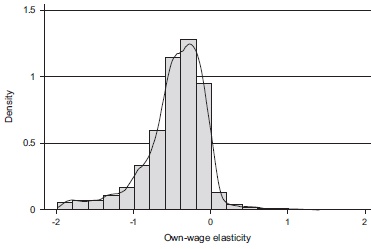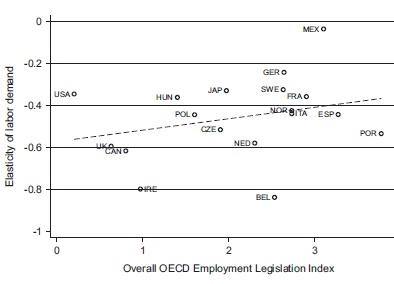When workers are cheaper, employers want more. But how many more? Does a 1% fall in the price of labor entice .1% higher employment? .5% more? 1% more? In technical terms, what is labor’s elasticity of demand? So much hinges on this seemingly boring question – everything from “How pro-worker is ‘pro-worker’ legislation?” to “Does the minimum wage, on balance, help low-skilled workers?” to “Are wage cuts a credible solution to mass unemployment?” to “What is the effect of immigration on native wages?”
The empirical literature, as you’d expect, is vast. But in 2015, the European Economic Review published a major meta-analysis. (Lichter et al.’s “The Own-Wage Elasticity of Labor Demand: A Meta-Regression Analysis“; ungated version here) This edifying piece begins with the distribution of earlier findings:
 Notice: As expected, labor demand elasticity has a negative slope, with modal estimates around -.4. But Lichter et al. naturally aren’t satisfied with a histogram. They break the results down by time period (short-run, intermediate-run, and long-run elasticity), model, dataset, and workforce characteristics. Here’s their big page of results.
Notice: As expected, labor demand elasticity has a negative slope, with modal estimates around -.4. But Lichter et al. naturally aren’t satisfied with a histogram. They break the results down by time period (short-run, intermediate-run, and long-run elasticity), model, dataset, and workforce characteristics. Here’s their big page of results.
Highlights (using absolute value for convenience, so “higher elasticity”=”a more negative elasticity”):
- Long-run elasticity is noticeably higher than short-run elasticity, a gap of .3 in the simple model and .15 in the full model.
- Panel data yields elasticities about .25 higher than other data.
- Demand for low-skilled, female, and atypical employment is markedly more elastic, an extra .21, .17. and .54 respectively.
Additional result: Labor demand is more elastic in countries with less labor regulation!
Fig. 4 plots the predicted labor demand elasticities against the country-specific OECD Employment Legislation Index. The graph shows a positive relationship between overall employment protection and the wage elasticity, with labor demand being less elastic in countries that have rather strict rules of employment protection legislation (for example, Spain and Mexico). In contrast, labor demand is more elastic in those countries that have weak rules on employment protection (for example, the UK and Canada). Differences in employment protection legislation among countries may thus contribute to the
country-specific estimates of the labor demand elasticity.
The graph:
 The authors conclude by testing for publication bias, and find fairly convincing evidence that researchers are hunting for statistical significance. The published paper leaves it at that, but the working paper includes “publication bias corrected” estimates:
The authors conclude by testing for publication bias, and find fairly convincing evidence that researchers are hunting for statistical significance. The published paper leaves it at that, but the working paper includes “publication bias corrected” estimates:
Our preferred estimate in terms of specification – the long-run, constant output elasticity obtained from a structural-form model using administrative panel data at the rm level for the latest mean year of observation, with mean characteristics on all other variables and corrected for publication selection bias – is -0.246, bracketed by the interval [-0.072;-0.446]. Compared to this interval, we note that (i) many estimates of the own-wage elasticity of labor demand given in the literature are upwardly in inflated (with a mean value larger than -0.5 in absolute terms) and (ii) our preferred estimate is close to the best guess provided by Hamermesh (1993), albeit with our confidence interval for values of the elasticity being smaller.
Who cares? In practice, almost no one. Twitter mentions for “labor demand elasticity” average about one per month! No politician who yearns for victory addresses this “boring” topic. But if people actually cared about the effects of labor market regulation on worker and human well-being, labor demand elasticity would fascinate them. An elasticity of -.25 implies that raising wages 4% permanently depresses employment by 1%. Considering the misery of involuntary unemployment and our hedonic adaptation to mere money, how can any thoughtful person yawn?


READER COMMENTS
Toby
Aug 17 2016 at 6:45am
Bryan:
Perhaps that’s just me, but I see (at least) three downward sloping lines instead of one upward sloping line.
How much weight should we attach to this positive association between strict labor market regulation and labor demand elasticity?
Also, should we read this as that labor market demand is relatively inelastic with stricter labor market regulation due to the fact the labor market regulation is by far the most important component the firms have to expend on hiring labor inputs?
Finally, how much weight do you attach to the correction for publication bias? I have heard some knowledgeable people say that it is near impossible to correct for it.
Toby
Aug 17 2016 at 6:48am
I agree otherwise with your overall point that it is indeed important. I was just wondering what your thoughts are on those topics. To me it seems that we can’t really say that much yet on this topic.
Robinson
Aug 17 2016 at 9:07am
I agree with Toby that there may be an instance of Simpson’s paradox in the employment-legislation to elasticity graph. In particular, it’s worth noting that the four English speaking language countries show an almost perfect negative linear relationship.
It does look like a cluster of European countries (Germany, Sweden, France) had both the highest legislation and (by a small margin) the highest elasticity, though the trend looks (at a glance) negative even within those countries. Could this be a cultural, political or historical confounder?
ThaomasH
Aug 17 2016 at 10:27am
About once a week I try making the point over on Cafe Hayek that they ought to frame their opposition to minimum wages in terms of how much unemployment is generated for the amount of income transferred to low income workers; that they ought to pay attention to the elasticity of demand for low wage labor. I have not yet been successful. 🙂
John Salvatier
Aug 17 2016 at 11:27am
I love these kinds of posts. “how can any thoughtful person yawn?” indeed.
What’s the definition of long/medium/short run here? Its not obvious from the post or the graphic.
Comments are closed.